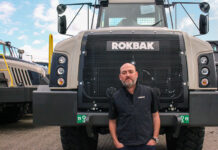Construction businesses are more likely to win bids if they can guarantee high-quality work, while sticking to a budget and a deadline. Meeting all three criteria can be a challenge, but could technology make it simple? Here, Peter Brooks, regional sales manager at SITECH, the UK & Ireland’s exclusive distributor of Trimble machine control technology, explores the answer.
ACCORDING to the UK Government, there were around 343,000 registered construction businesses operating in 2019 — new orders to the industry in 2018 were worth around £61.7 billion. In a competitive marketplace, construction businesses cain gain a competitive edge by proving that they can offer a better service at a better price.
Investing in tools to improve productivity could be the answer, as they can reduce the need for reworking, reduce material costs and therefore help meet a customer’s expectations in term of budget and time frame.
On the same page
Communication between all parties is vital to a successful construction project. Designers, architects, surveyors, engineers and machine operators must coordinate to ensure that every process is completed accurately and to deadline. Parties often exchange paper plans across teams, so any changes are slow to reach operators completing the physical work. Working from a paper plan also means that surveyors need to regularly check that every member of the team is working to the latest revision of the design.
Moving to digital communication can speed up the distribution of 3D Models to reduce the risk of errors. For example, machine control technology can be fitted to machines cabs so that operators can directly receive the 3D computer aided design (CAD) model from the surveyors or designers. Two-way data flow between equipment operators and the office means any changes can be communicated immediately and everyone is on the same page. In addition, surveyors and designers can send design changes straight to the machine and operators have the ability to record as built data manually or automatically to enable surveyors and the project team to see volumes and progress to keep everyone updated on the status of the work. An added bonus is that if urgent assistance is needed on the machine, the machine control provider (SITECH) or the surveyors can also offer immediate remote advice and assistance by communicating directly with the system on the machine over a GSM link.
No second guessing
When removing material from a site in preparation for new infrastructure, operators have to consider a variety of factors to ensure they dig efficiently, safely, accurately and within tolerance. Adding material is more expensive than removing existing material, so operators are often cautious at this stage of a project. An operator inside the cab and an engineer outside will work together to ensure machinery is ready to dig at the correct level and will slowly remove or fill material in layers.
Fitting machinery with Trimble Earthworks technology means that the operator has all the information they need inside the cab. Operators can simply input data from the 3D Models into the machine and excavate materials precisely, improving the accuracy of the work completed and reducing the time taken to excavate. In a study by Trimble and Caterpillar that compared conventional equipment to digitised construction equipment, the same work was completed in almost half the time with less than half the passes and twice the accuracy.
As construction companies see the accuracy of their work increase, while reducing the time taken to complete work, they will also see a reduction in costs. For example, more accurate excavation and movement of material will lead to reductions in fuel consumption and material costs. Once contractors see these savings, they can price up potential bids more efficiently and ensure that clients get the best service possible, meeting both their expectations and their budget.
A gradual process
Technology isn’t a quick fix that businesses should hurry to invest in to compete with the hundreds of other businesses operating the UK. Taking the time to find the right solution will help construction businesses see the most return on investment.
Our consultants work with contractors to review a project and a customer’s existing fleet before suggesting any technology. Then, construction businesses can trial the right machine control system for them, key is making sure at an early stage that the system is a flexible as possible. Fitting several machines with install kits, and then having a flexible machine control system which is easily transferable across their fleet of varying machine types, is usually the most cost effective way forward.










